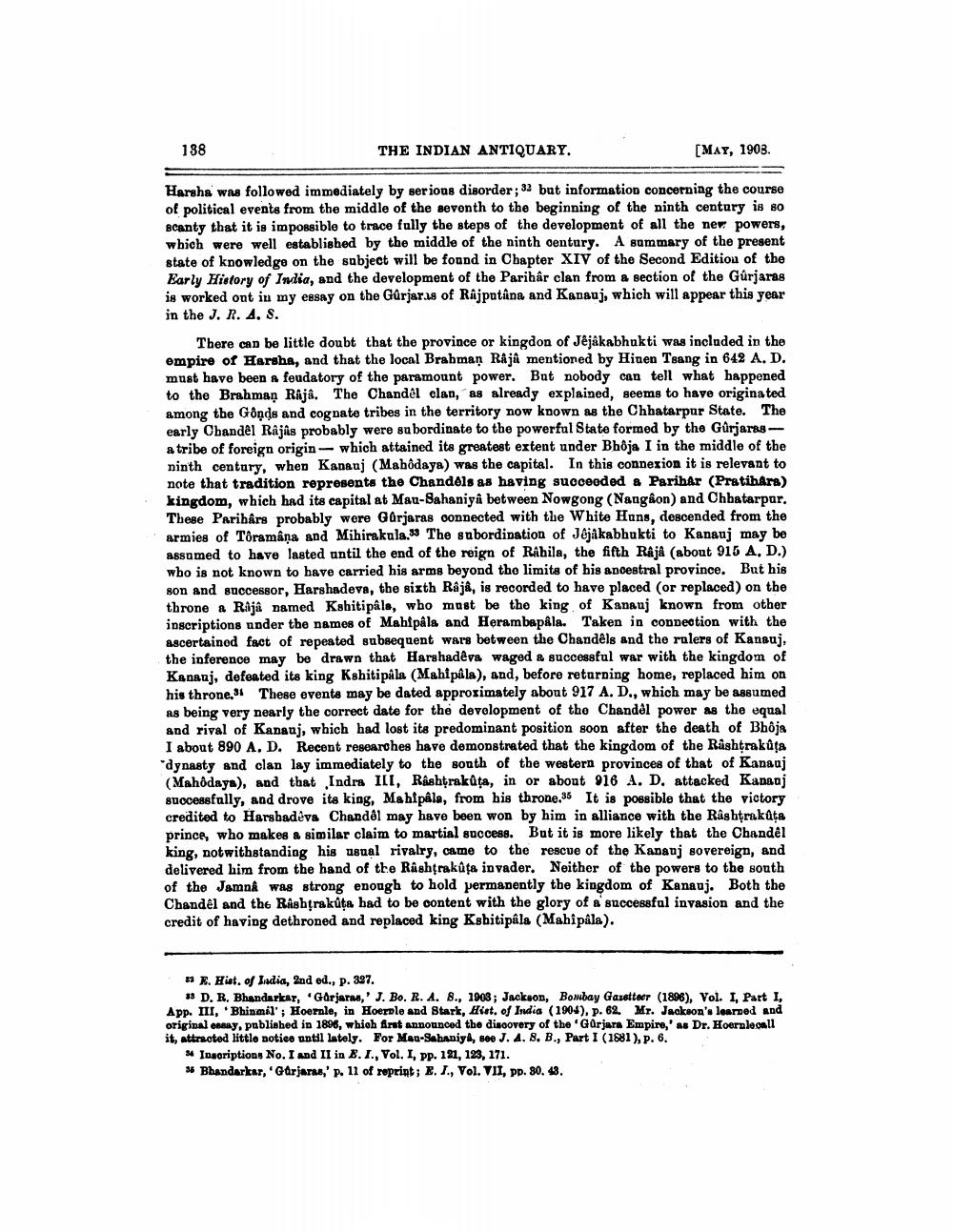________________
138
THE INDIAN ANTIQUARY.
[MAT, 1903.
Harsha was followed immediately by serious disorder; 32 but information concerning the course of political events from the middle of the seventh to the beginning of the ninth century is so scanty that it is impossible to trace fully the steps of the development of all the new powers, which were well established by the middle of the ninth century. A summary of the present state of knowledge on the subject will be found in Chapter XIV of the Second Edition of the Early History of India, and the development of the Parihâr clan from a section of the Gurjaras is worked ont in my essay on the Gurjaras of Rajputâna and Kanauj, which will appear this year in the J. R. A. S.
There can be little doubt that the province or kingdon of Jêjâkabhukti was included in the empire of Harsha, and that the local Brahman Râjâ mentioned by Hiuen Tsang in 642 A. D. must have been a feudatory of the paramount power. But nobody can tell what happened to the Brahman Raja. The Chandel clan, as already explained, seems to have originated among the Gônds and cognate tribes in the territory now known as the Chhatarpur State. The early Chandel Râjâs probably were subordinate to the powerful State formed by the Gurjarasa tribe of foreign origin which attained its greatest extent under Bhôja I in the middle of the ninth century, when Kanauj (Mahôdaya) was the capital. In this connexion it is relevant to note that tradition represents the Chandels as having succeeded a Parihar (Pratihara) kingdom, which had its capital at Mau-Sahaniyû between Nowgong (Naugaon) and Chhatarpur. These Parihârs probably were Gurjaras connected with the White Huns, descended from the armies of Tôramâna and Mihirakula.33 The subordination of Jejakabhukti to Kanauj may be assumed to have lasted until the end of the reign of Rahila, the fifth Raja (about 915 A, D.) who is not known to have carried his arms beyond the limits of his ancestral province. But his son and successor, Harshadeva, the sixth Rajâ, is recorded to have placed (or replaced) on the throne a Raja named Kshitipâle, who must be the king of Kanauj known from other inscriptions under the names of Mahipala and Herambapâla. Taken in connection with the ascertained fact of repeated subsequent wars between the Chandels and the rulers of Kanauj, the inference may be drawn that Harshadêva waged a successful war with the kingdom of Kanauj, defeated its king Kshitipala (Mahipala), and, before returning home, replaced him on his throne. These events may be dated approximately about 917 A. D., which may be assumed as being very nearly the correct date for the development of the Chandêl power as the equal and rival of Kanauj, which had lost its predominant position soon after the death of Bhôja I about 890 A. D. Recent researches have demonstrated that the kingdom of the Rashtrakuta dynasty and clan lay immediately to the south of the western provinces of that of Kanauj (Mahôdaya), and that Indra III, Rashtrakuta, in or about 916 A. D. attacked Kananj successfully, and drove its king, Mahipala, from his throne.35 It is possible that the victory credited to Harshadêva Chandêl may have been won by him in alliance with the Rashtrakuta prince, who makes a similar claim to martial success. But it is more likely that the Chandel king, notwithstanding his usual rivalry, came to the rescue of the Kanauj sovereign, and delivered him from the hand of the Rashtrakuta invader. Neither of the powers to the south of the Jamna was strong enough to hold permanently the kingdom of Kanauj. Both the Chandel and the Rashtrakuta had to be content with the glory of a successful invasion and the credit of having dethroned and replaced king Kshitipâla (Mahipala).
za E. Hist. of India, 2nd ed., p. 327.
33 D. R. Bhandarkar, 'Gurjaras, J. Bo. R. A. 8., 1903; Jackson, Bombay Gazetteer (1896), Vol. I, Part I, App. III, Bhinmal'; Hoerale, in Hoerple and Stark, Hist. of India (1904), p. 62. Mr. Jackson's learned and original essay, published in 1896, which first announced the discovery of the 'Gurjara Empire,' as Dr. Hoernle.call it, attracted little notice until lately. For Man-Sahaniya, see J. A. 8. B., Part I (1881), p. 6.
34 Inscriptions No. I and II in E. I., Vol. I, pp. 121, 123, 171.
36 Bhandarkar, 'Gurjaras,' p. 11 of reprint; E. J., Vol. VII, pp. 80. 43.




